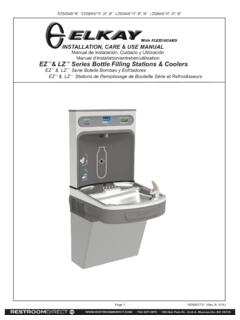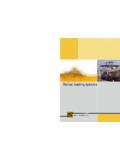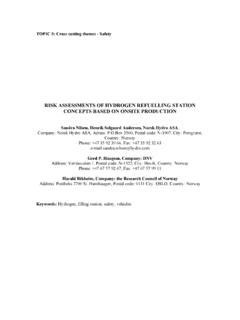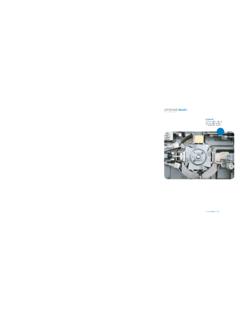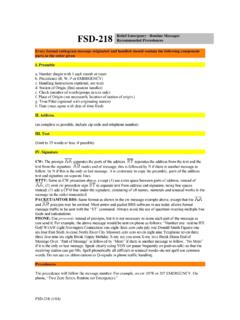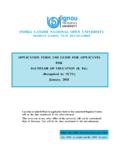Transcription of GUIDELINES FOR CONSTRUCTION OF PETROL …
1 GUIDELINES FOR CONSTRUCTION OF PETROL STATIONS 1. MINIMUM STANDARD REQUIREMENTS OF A PETROL filling station A PETROL filling station should have at least: One underground storage tank for each petroleum product sold at the station with a minimum capacity of 5 m3 One digital dispensing pump (two-way) for each petroleum product sold at the station . All dispensing pumps should be covered. One service bay One wash bay One generation Offices One wastewater drainage system Fire fighting equipments 2. UNDERGROUND STORAGE TANKS (UST) It is required that petroleum storage tanks and filling stations be licensed and regulated to conform with minimum standards that meet basic safety, health, operational and environmental protection.
2 3. CONSTRUCTION UST shall as a minimum requirement be single walled of rolled carbon steel plates welded together. All storage tanks at retail dispensing sites shall be placed underground. The tank shall have a protective coating. As a minimum requirement, the tank shall be painted with a primer, and then coated with epoxy, coal tar epoxy or similar bituminous coating. Where the water table is high, additional protective coating measures must be undertaken. An environmental impact assessment shall be done before CONSTRUCTION of UST, filling stations and storage tanks is permitted. A site soil analysis should be done to determine the type of soil, density, resistively bearing pressure and depth of water table.
3 2 Where aggressive soils have been encouraged and where the water table is high, cathodic protection should be used for single steel walled tanks. Otherwise, secondary contained tanks, , a double-walled steel tank, double walled fiberglass or jacketed steel tanks (with high density polythene or fiberglass outer wall) should be used. Suitable sand shall be used for both bedding and backfilling of steel tanks. Installed tank and pipe work shall be hydrostatically tested. UST to be located so that delivery trucks do not unduly block forecourt traffic. UST location to allow trucks to reach all fill pipes using normal hose length. UST location to provide a forecourt gradient that allows complete drainage of delivery truck compartments.
4 UST location to allow minimum maneuvering of truck before and after delivery including ability to exit in forward direction. UST shall be installed to avoid traffic load and should be sufficiently protected from traffic by using barriers. Placement of UST under canopy should be avoided. 4. ENVIRONMENTAL PROTECTION MEASURES Environmental impact assessment shall be done before licensing and CONSTRUCTION of any GFT. Periodic environmental audits shall be performed regularly on already existing tanks. Employees and public health protection measures must be assured. These must include insurance coverage for the staff and third party. Product testing/update laboratories is a prerequisite for establishment and operation of GFT.
5 Approved drawings of a bulk storage depot/tanks shall indicate at minimum but not limited to the following: o Nature and quantities of the products to be stored o Distance between tanks o Distance between storage and adjoining property o Lighting arrangements o Certification by a registered engineer o Floating/screen roof shall be installed on the GFT and regularly checked to safeguard against unnecessary evaporation losses 3 5. FIRE FIGHTING PROTECTION In addition to measures mentioned UST, fire water storage and supply shall be sufficient to give at least 6 hours of cooling water cover in case of fire. Fire foam system shall provide protection to fire vulnerable areas (tanks loading rack, etc.). Water system shall be installed around GFT to ensure safeness in case of fire outbreak.
6 6. CALIBRATION AND MAINTENANCE OF EQUIPMENTS GFT must be calibrated in accordance with recommended standards. All calibration equipments must be proved and certified by competent firms/individuals within a recognized period of time, for instance 5 years for GFT and meters every 6 months. 7. WASTEWATER MANAGEMENT The forecourt should be designed with drain channels to capture all wastewater from the forecourt, wash bays and service bays. The wash water shall be directed to a suitably designed three chamber oil interceptor to separate oil before the effluent is permitted to flow in public storm water system. Effluent going into the public waterways should be monitored regularly and records maintained to ensure that it does not exceed the required limits.
7 8. VAPOUR VENTS UST should be fitted with appropriately sized vapour vents. Vents should terminate in open air in such a position that flammable vapours will not accumulate or travel to unsafe place. 9. FIRE FIGHTING A fire master certificate should be issued for any new retail dispensing or storage facility. An appropriate inventory of fire extinguishers, at least two of 9 kgs of chemical powder, should be available at the site and the extinguishers shall be tested every six months. No smoking and no cell phone usage signs shall be significantly displayed in the forecourt. 4 10. FILL PIPES All direct fill pipes should be of the same diameter as the outlet of the fuel delivery truck. Each tank should have its own fill pipe and the size of the fill pipe should correspond to the size of delivery truck outlets.
8 At the fill point the pipe shall determine with a tight fill adapter and a lockable fill cap. A spill containment device such as a stump should be fitted at the fill point to prevent spill soaking directly into backfill and contaminate the ground. Fill point sea caps should remain securely locked at all times to prevent unauthorized tampering with the products. Periodic environmental audits shall be performed as directed by Rwanda Environment Management Authority (REMA). 11. LICENSING PROCEDURES All GFT, UST and filling stations must be licensed to operate. Any modification or alteration on the existing GFT, UST and filling stations must be licensed. Licensing procedure. The following are licensing procedures: o An application must be received and registered by the relevant authorities.
9 O Plans and drawings will be checked for site location, site size, structures and traffic flow. o Applications will then be reviewed and approved by REMA for environmental compliance. o Then relevant organization will give the final approval and these are: Local/Municipal Authority REMA Ministry with Energy Portfolio MINICOM and RURA To keep records in a standard form so that at any time data can be obtained. To have permis d exploitation and a trade license. 5 12. PLANNING CRITERIA FOR LOCATION OF PETROL filling STATIONS Stations should be located within a growth center or an urban area except in circumstances where it can be shown through appropriate studies that the need exists otherwise.
10 Stations should be located at a minimum of 100 m from any public institution such as schools, churches, public libraries, auditoriums, hospitals, public playgrounds, etc. However, other small and medium commercial activities may be located within the specified limits. Distance between one PETROL station and another: 150 m Area of land to be developed should be sufficient to allow maneuvering of vehicles within its cartilage but should not be less than 1100 m2 with a minimum frontage of 9 m on the primary street. filling Stations will not be allowed in any area where the traffic situation is such that it will cause obstructions in entering or leaving a station or on tight curves where visibility is not adequate.
